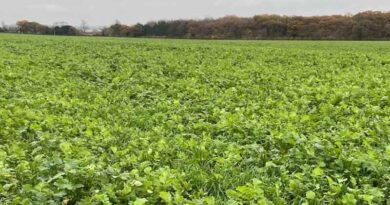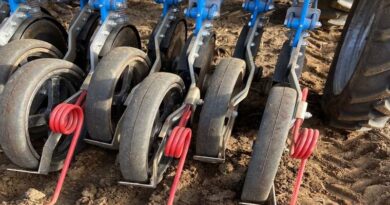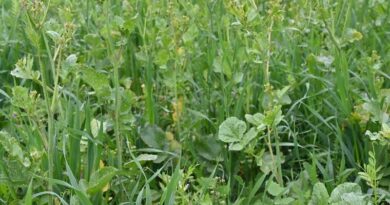Growers undercover investigations for spring crop establishment
17 February 2021, UK: On the traditional high quality spring barley light soils in Kent, Andrew Barr reports the numerous benefits of cover crops mean it’s not a question of if to use them, but more how can they make them work in every instance.
“I am constantly tinkering with the mix as I try new species and see how they work. This year I primarily grew linseed, phacelia, radish, mustard, beans, peas, buckwheat, red clover and vetch, with a small amount of rye and oats,” reported Mr Barr (below). The latter meant the mix could qualify for EFA payments, which have elapsed.

“I have found it very important that for any cover crop before spring barley not to have very much of any other cereal at all. In my trials, even leaving the wheat volunteers in the mix from the previous crop has had a detrimental effect on spring barley yields” he advised.
From experience, he warns that for growers new to growing cover crops over the winter it does take time to adapt to the system, particularly where there are a lot of cereals in the rotation ahead of spring barley.
For spring barley cropping on East Lenham Farm, the key benefit of cover crops has been soil health – both in structure and biology, along with stopping nutrients being lost from the system.

“When we started cutting down on tillage it became apparent that if we had bare soil over winter, the structure really suffered. The cover crop roots now take the place of our previous tillage.”
He also highlighted a significant amount of nitrogen can be lost to leaching if nothing is growing, which can be effectively conserved in the cover crop. The roots also pull up other nutrients from deeper in the soil, along with adding to the soil’s organic matter.
“In addition, many beneficial insects such as carabid beetles can live in cover crops that would not be there if the soil was bare.”
Prior to the farm’s spring barley establishment, on a direct drill conservation agriculture system, Mr Barr advocates destroying the cover crop early. That ensures the green material can break down without locking up early nitrogen, and the soil dries out and you can drill easier.
“Obviously the longer you leave your cover crops into spring, the more N they can mop up or fix and the more you will get back eventually, but personally I haven’t got on well yet drilling spring barley into green material – although spring oats and beans in particular have worked.”
His aim is to have spring barley drilled by the end of March. But it is conditions, rather than date, that dictate timing. “My light land, in particular, is poor once drilling slips into April, if the rain stops.
A long-term advocate of direct drilling, Mr Barr reports the Syngenta Conservation Agriculture project, to compare a conventional plough-based establishment with minimal tillage and direct drill systems, has already proven very useful.

“We have, on occasions, got slightly lower yield by direct drilling vs tillage, but margins have still been equivalent due to reduced establishment cost.”
Under the low tillage system he advocates all of the crop’s N should be applied before or at drilling, especially after cover crops.
“The problems we have had with direct drilling have been due to rapid drying out after drilling. We’ve now changed the set up on our drill, to have a disc followed by tine, which really got our spring barley away well last year. It yielded as well as the tillage system establishment, at lower cost.
“We believe that direct drilling can be effective for spring barley establishment; it’s a question of keep experimenting until we get it to work consistently.”
On the heavier land of the Allerton Trust, at Loddington in Leicestershire, Phil Jarvis would always aim to integrate cover crops ahead of spring cropping – primarily for payments under stewardship schemes and to mitigate the effects on increasingly frequent heavy rainfall events.
“We are looking for erosion control, fertility and feeding ‘the soil wildlife’, along with sheep feed in a mixed farming system.”

Whilst they do offer significant benefits, he warned that poor seedbeds in spring and having to wait can have knock-on effects into next season.
“We tend to use a standard oil radish, oat, phacelia mix. Although with a watch-out for rotational diseases, a buckwheat, linseed and phacelia mix, with no cereal, might be a better mix before spring barley,” he suggested.
Mr Jarvis pointed out that spring cropping for grass weed control is major part of an IPM approach, to reduce blackgrass seed numbers.
“You may not want a really thick cover crop, if glyphosate is used to clean ground before drilling,” he advised.
The cover crops are destroyed as soon as rules permit, with glyphosate his preferred method. Although rolling and sheep grazing have also been used.
“You need to let some sunlight in, to dry the soil. Soil temperature is key for spring crop establishment, as our cold wet heavy soils always take longer for spring sowings to get underway.”

“Drilling straight into cover crop is my preferred option, with the structuring either by the cover crop or by a shallow tine prior to cover crop establishment when conditions are generally drier in the autumn. You can also combine the tine operation with the sowing of cover crops, which keeps establishment costs down” He typically leaves spring drilling until the end of March, since soils are rarely warm enough until then.
Reduced and shallower cultivations, along with less N on spring barley will have a role to play in the farm’s carbon calculation, advocated Mr Jarvis.
“In general, cover crops and this more regenerative approach means lower cultivation costs, reduced fertiliser use and more targeted crop protection as a whole farm IPM approach – that will hopefully lead to a better gross margin.”















